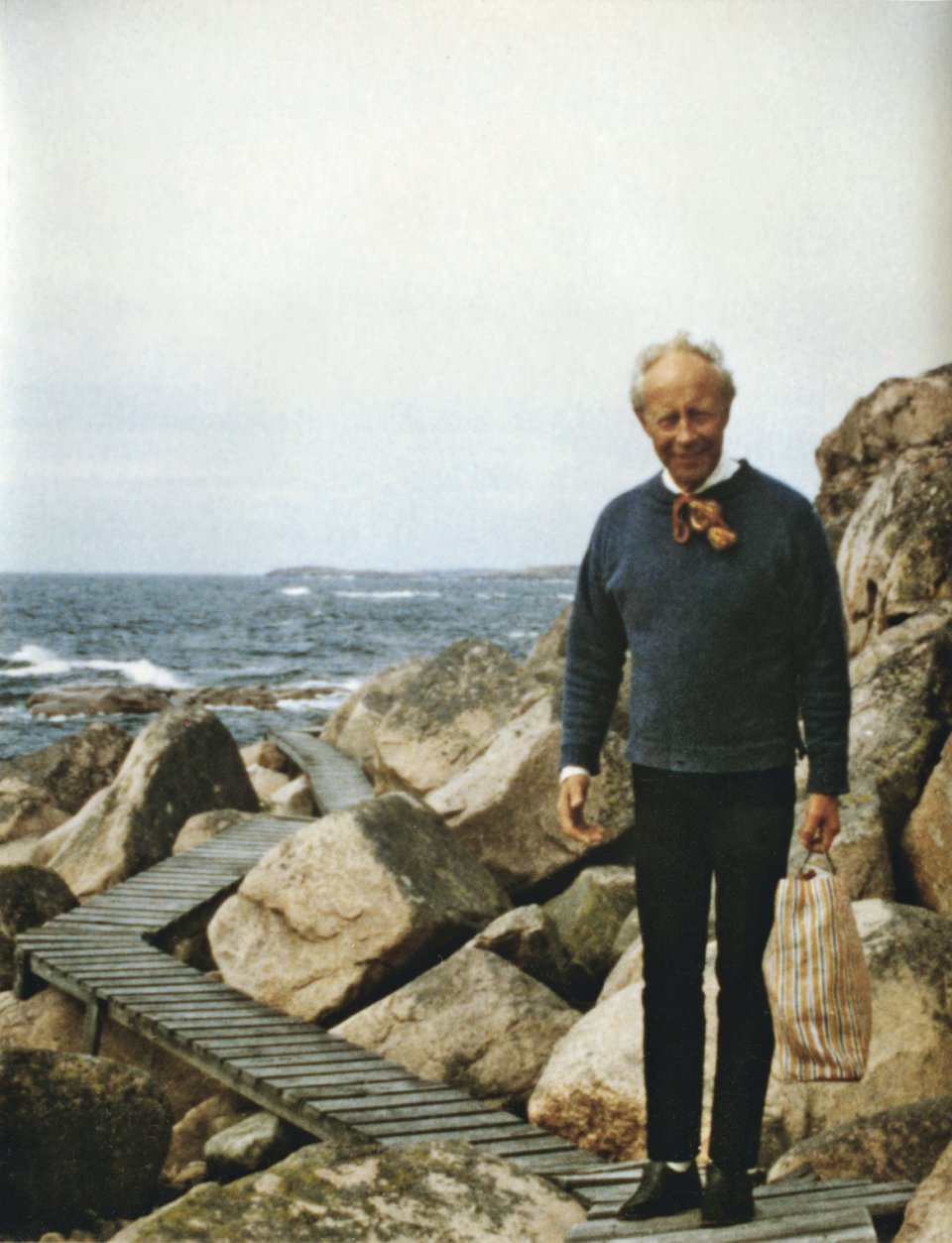Why did Tove Jansson make an exception and include Moomin-themed figures in a painting? Who was the eccentric nobleman who wanted to hang a Tove Jansson painting over the fireplace in his cottage on Källskär? How can the Fillyjonks and the sea creature in the painting be interpreted? Watch the mini-documentary ”Wild Cliffs – Tove Jansson and the Unique Painting on the Åland Islands” to find out!
In the video, Tove Jansson experts, local guides and art historians share the fascinating and entertaining story of how the unique Källskär painting came to be and it also includes never-before-seen footage filmed by Tove Jansson’s partner Tuulikki Pietilä.
An Intriguing Commission
Tove Jansson was quite adamant about separating her fine art painting and the Moomin world she created, but there is one exception: the Källskär painting from 1960. It is the only Moomin-themed painting Tove Jansson made, and it was a commission from her soon-to-be friend, the eccentric nobleman Göran Åkerhielm.
In the 1950s, the Moomins and Tove Jansson had grown very famous. One of her fans was Göran ”The Count of Källskär” Åkerhielm, a Swedish nobleman who wanted a Tove Jansson original painting to hang above his fireplace on the remote island of Källskär, located in the Southern most part of the Åland Islands in the Finnish archipelago. Åkerhielm, who was gay, had moved to Källskär after receiving an ultimatum from his father: move abroad and get your inheritance or stay in Sweden and get disinherited.

After many twists and turns, involving dressing in a Swedish costume and surprising Tove’s mother, Signe Hammarsten Jansson, at home as well as flying to Paris, Göran managed to commission a Moomin-themed painting from the initially reluctant Tove Jansson.
”do something with wild cliffs, why not a hysterical Fillyjonk, a sea creature or actually whatever.”
Tove Jansson and Göran Åkerhielm became friends after this and Tove and her life partner Tuulikki Pietilä visited Källskär several times. Pietilä loved to film with her Super 8 camera on their trips, and in the mini-documentary, there is never-before-seen footage from one of their visits.
The only Moomin Themed Painting by Tove Jansson
According to art historian Tuula Karjalainen, known for her book Tove Jansson: Work and Love, the Källskär painting is very different from Tove Jansson’s other paintings. However, it is closely related to the Moomin illustrations as well as the murals painted by Tove in the 1930s and 1940s. The Moomin illustrations have a function; they are telling a story, which is also the case with the murals. With both murals and Moomin illustrations, there is a clear purpose and commission to follow. Tove Jansson very rarely accepted commissions for paintings, and she did not want to mix her fine art and her Moomins. Hence, the Källskär painting is unique with its elements from the Moomin stories, which include two Fillyjonks, a fairy tale like sea creature, the shell and pearl and the pointy mountains.
”The colours are also quite different from her other paintings. It’s like a coloured Moomin illustration, which does not mean I don’t appreciate the painting”, says Karjalainen. She continues:
”When I saw the painting for the first time, I wondered why Tove had painted it. Then I understood that it was a commission from someone who knew what he wanted. It’s a piece painted by a friend for a friend.”
“It’s a piece painted by a friend for a friend.”
Karjalainen also explains that abstract painting was the trendy way to paint in the 1950s. Tove Jansson was always a storyteller, even when she painted, making her a bit of an outsider in the art world at that time. She also had the huge success of the Moomins, which demanded all of her time. There was no time for painting and the Källskär painting was one of her last works. According to Karjalainen, the Moomin world is not only a theme in the painting, but the painting can also be seen as emblematic of how painting was pushed out of Tove’s life by the Moomins after this. ”I find it quite sad, because I really appreciate Tove as a fine artist”, Karjalainen states.
When asked to analyse the painting, Karjalainen says that she interprets the two Fillyjonks as Tove Jansson and Tuulikki Pietilä and the sea creature as Göran Åkerhielm. The shell that the sea creature is holding is a gift, which symbolises how Åkerhielm is giving the gift of the wonderful and distinctive scenery of Källskär to Jansson and Pietilä. They visited the island many times, there is even a house on the top of the island still called Tove’s cabin, but it must be said that the visits did present some challenges for the couple. The visits included everything from saunas that weren’t hot enough to strict rules about having to help out with the manual labour on the island in order to get dinner, something that Pietilä especially did not appreciate.
Want to get the whole story of the eccentric ”Count of Källskär” and the birth of the Källskär painting? Watch the mini-documentary “Wild Cliffs – Tove Jansson and the Unique Painting on the Åland Islands” below!
Photo of the Källskär painting: Robert Jansson, Åland Art Museum
